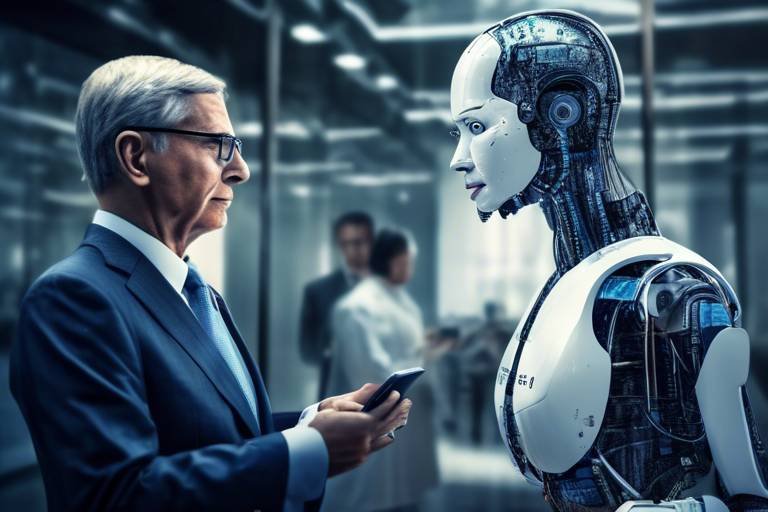The Era of AI: Changing Dimensions of Corporate Training
In today's fast-paced corporate world, the integration of artificial intelligence (AI) into training programs is not just a trend; it's a revolution. Imagine a workplace where every employee has access to a personalized learning journey tailored specifically to their needs. This is the future of corporate training, and it’s happening right now! AI is reshaping the way organizations approach employee development, making learning not only more efficient but also infinitely more engaging. With the advent of smart technologies, training is evolving from a one-size-fits-all model to a dynamic, interactive experience that resonates with each individual.
Gone are the days when employees had to sift through hours of generic training videos or attend lengthy seminars that didn’t cater to their specific roles or learning styles. Instead, AI-driven platforms analyze individual performance and preferences, crafting a unique training path for each employee. This means that whether someone is a visual learner, prefers hands-on experiences, or thrives on verbal instructions, AI can adapt the content accordingly. It’s like having a personal coach who knows exactly what you need to succeed!
The implications of this shift are profound. Not only does personalized training enhance employee satisfaction and retention, but it also leads to improved performance and productivity. When employees feel that their unique learning needs are being met, they are more likely to engage with the material, apply what they learn, and contribute meaningfully to their teams. This is a win-win scenario for both employees and employers, creating a culture of continuous improvement and innovation.
Moreover, the data-driven nature of AI allows organizations to gain invaluable insights into the effectiveness of their training programs. Imagine having the ability to analyze which training modules are most effective, where employees struggle, and what adjustments can be made for future sessions. This level of detail enables companies to optimize their training strategies continuously, ensuring that they are always aligned with their employees’ needs and the ever-changing demands of the market.
As we delve deeper into this exciting era of AI in corporate training, it’s essential to recognize that while the benefits are substantial, there are also challenges that organizations must navigate. Resistance to change, data privacy concerns, and the need for significant investment in technology are just a few hurdles that companies may face. However, with the right approach and a commitment to fostering a culture of learning and innovation, these challenges can be overcome.
In conclusion, the era of AI is not just changing the dimensions of corporate training; it is redefining the very essence of how employees learn and grow within their organizations. By embracing these innovative technologies, companies can create a more skilled, knowledgeable, and engaged workforce, ready to tackle the challenges of tomorrow.
- What is AI in corporate training?
AI in corporate training refers to the use of artificial intelligence technologies to enhance the learning experience for employees by personalizing content and adapting to individual learning styles.
- How does AI improve employee engagement?
AI improves engagement by making learning interactive and enjoyable through the use of gamification, simulations, and personalized feedback.
- What are the main challenges of implementing AI in training?
The main challenges include resistance to change, ensuring data privacy and security, and the need for substantial investments in technology.
- Can AI training be scaled for large organizations?
Yes, AI technologies allow organizations to efficiently scale their training programs to accommodate a larger workforce without compromising quality.

The Impact of AI on Learning Methods
Artificial Intelligence (AI) is not just a buzzword; it's a game-changer in the realm of corporate training. Imagine walking into a training session tailored just for you—sounds like a dream, right? Well, with AI, that dream is becoming a reality. Traditional learning methods often adopt a one-size-fits-all approach, which can leave many employees feeling disengaged and unmotivated. In contrast, AI introduces a wave of personalization that transforms how employees learn. By leveraging data, AI can adapt content and learning paths based on individual performance and preferences, ensuring that each employee receives a training experience that resonates with them.
One of the most exciting aspects of AI in learning is its ability to implement adaptive learning techniques. This means that as an employee progresses through their training, the AI system analyzes their strengths and weaknesses in real-time. If someone struggles with a particular concept, the system can adjust the training materials accordingly, providing additional resources or alternative explanations. This level of responsiveness is akin to having a personal coach who knows exactly what you need to succeed. It not only enhances the learning experience but also boosts confidence, leading to better performance on the job.
Furthermore, AI-driven platforms can analyze vast amounts of data to identify trends and patterns in learning behaviors. For example, if a significant number of employees find a specific module challenging, organizations can quickly take action to revise the content or offer supplementary resources. This proactive approach ensures that training remains relevant and effective, ultimately fostering a culture of continuous improvement. The result? A workforce that is not just skilled, but also adaptable and ready to tackle the challenges of an ever-evolving business landscape.
To illustrate the impact of AI on learning methods, consider the following table that highlights key differences between traditional and AI-driven training:
| Aspect | Traditional Training | AI-Driven Training |
|---|---|---|
| Personalization | One-size-fits-all | Customized learning paths |
| Feedback | Delayed feedback | Real-time feedback |
| Adaptability | Static content | Dynamic content adjustments |
| Engagement | Passive learning | Interactive experiences |
In summary, the integration of AI into corporate training is not merely an enhancement; it represents a fundamental shift in how organizations approach employee development. By embracing these innovative technologies, companies can create a more engaging, effective, and personalized learning environment that ultimately leads to a more skilled workforce.
- What is AI-driven corporate training? AI-driven corporate training utilizes artificial intelligence technologies to customize and enhance training experiences for employees.
- How does AI personalize learning? AI analyzes individual employee data to tailor training programs that meet specific needs, preferences, and learning styles.
- Can AI improve employee engagement? Yes, by incorporating interactive elements such as gamification and simulations, AI can make learning more enjoyable and engaging.
- What challenges might organizations face when implementing AI in training? Common challenges include resistance to change, data privacy concerns, and the need for significant investment in technology.

Benefits of AI-Driven Corporate Training
In today's fast-paced corporate world, the integration of artificial intelligence into training programs is not just a trend; it's a necessity. The benefits of AI-driven corporate training are profound, reshaping how organizations approach employee development. Imagine a world where training is not a one-size-fits-all solution but a tailored experience that adapts to each employee's unique needs. This is the reality that AI brings to the table. By harnessing the power of AI, companies can significantly enhance engagement, provide real-time feedback, and improve retention rates, resulting in a more skilled and knowledgeable workforce.
One of the standout advantages of AI-driven training is its ability to foster enhanced engagement. Traditional training methods often fall flat, leaving employees feeling disconnected and uninspired. However, with AI, training can become interactive and enjoyable. Think of it like turning a dull lecture into an exciting game; employees are not just passive recipients of information, but active participants in their learning journey. By incorporating elements like gamification and simulations, AI tools create a learning environment that captivates and motivates employees to invest in their own growth.
Moreover, AI offers real-time feedback, a game-changer in the training landscape. Instead of waiting for weeks or even months to receive feedback on performance, employees can now receive immediate insights into their progress. This instant feedback loop not only helps in identifying strengths and weaknesses but also fosters a culture of continuous improvement. Employees can adjust their learning paths on the fly, ensuring that they are always on track to meet their goals. It's like having a personal coach available 24/7, guiding them every step of the way.
Another critical benefit is the improvement in retention rates. Studies show that personalized learning experiences lead to higher retention of information. When training is tailored to individual learning styles and preferences, employees are more likely to absorb and retain knowledge. AI can analyze data from previous training sessions to identify what works best for different employees, allowing organizations to refine their training programs continuously. It’s akin to having a roadmap that guides you through the learning process, ensuring you don’t take unnecessary detours.
Furthermore, AI-driven corporate training equips organizations with data-driven insights. By analyzing employee performance and engagement metrics, companies can pinpoint areas that need improvement. This data-centric approach allows organizations to optimize their training strategies and ensure that resources are allocated effectively. Imagine running a marathon without a training plan; it’s likely you would struggle to finish. With AI, organizations can create a structured training regimen that maximizes employee potential and minimizes wasted effort.
Lastly, the scalability of AI technologies means that organizations can expand their training programs effortlessly. Whether a company has ten employees or ten thousand, AI can accommodate growth without sacrificing the quality of training. This scalability is crucial in today’s dynamic business environment, where companies must adapt quickly to changes. AI ensures that as the workforce grows, the training remains effective and relevant.
- What is AI-driven corporate training? AI-driven corporate training utilizes artificial intelligence technologies to personalize and enhance the learning experience for employees.
- How does AI improve employee engagement in training? AI improves engagement by making learning interactive, incorporating gamification, and providing real-time feedback.
- Can AI training programs be scaled? Yes, AI technologies allow organizations to scale their training programs efficiently without compromising quality.
- What are the data privacy concerns with AI in training? Organizations must ensure compliance with data protection regulations and prioritize the security of sensitive employee information when implementing AI solutions.

Personalization in Training Programs
In today's fast-paced corporate environment, one-size-fits-all training programs are becoming a thing of the past. With the advent of artificial intelligence, organizations can now create highly personalized training experiences that cater to the unique needs of each employee. Imagine walking into a training session that feels like it was designed just for you—tailored to your learning style, pace, and career aspirations. This is the power of AI-driven personalization in corporate training.
AI algorithms analyze vast amounts of data, including employee performance metrics, learning preferences, and even feedback from previous training sessions. This information is then used to customize training content, ensuring that employees receive the most relevant materials. For instance, if an employee excels in visual learning but struggles with auditory instructions, the AI can adjust the training format accordingly, providing more videos and infographics while minimizing traditional lectures.
Moreover, personalization doesn't just stop at content delivery. It extends to learning paths as well. Employees can embark on individualized learning journeys that align with their career goals. For example, a marketing professional looking to transition into data analytics can receive specialized training modules that equip them with the necessary skills, rather than being lumped into a generic program. This not only enhances engagement but also boosts confidence, as employees feel more in control of their professional development.
Additionally, the use of AI allows for continuous adaptation of training programs. As employees progress through their learning paths, the AI can identify areas where they may need further support or challenge them with advanced materials if they are excelling. This dynamic approach ensures that training remains relevant and effective, creating a culture of lifelong learning within the organization.
To illustrate the impact of personalization in training programs, consider the following table that outlines key benefits:
| Benefit | Description |
|---|---|
| Increased Engagement | Employees are more likely to participate in training that feels relevant to their roles and interests. |
| Improved Retention | Personalized content helps employees retain information better, as it resonates with their learning styles. |
| Enhanced Skill Development | Tailored training paths lead to more targeted skill acquisition, preparing employees for future challenges. |
| Greater Job Satisfaction | When employees see that their organization invests in their personal growth, it fosters loyalty and satisfaction. |
In conclusion, personalization in training programs is not just a trend; it's a necessity for organizations aiming to cultivate a skilled and motivated workforce. By leveraging AI technologies to create customized learning experiences, companies can ensure that their employees are not only engaged but also equipped to thrive in an ever-evolving business landscape.
- What is AI personalization in corporate training? AI personalization refers to the use of artificial intelligence to tailor training programs based on individual employee needs, preferences, and performance metrics.
- How does AI improve employee engagement in training? AI enhances engagement by making learning interactive and relevant, allowing employees to participate in training that resonates with their personal and professional goals.
- Can AI-driven training programs adapt over time? Yes, AI technologies continuously analyze employee progress and can adjust training content and paths accordingly to ensure optimal learning outcomes.

Data-Driven Insights for Improvement
In the ever-evolving landscape of corporate training, data-driven insights play a pivotal role in enhancing the effectiveness of learning programs. With the integration of artificial intelligence, organizations can leverage vast amounts of data to gain a clearer understanding of how training initiatives are performing. This is not just about collecting numbers; it's about transforming raw data into actionable strategies that can significantly improve employee performance and engagement.
Imagine a scenario where training programs are tailored not just to meet general company standards but are specifically designed based on individual employee performance metrics. AI systems analyze data from various sources—such as assessments, feedback forms, and even employee interactions—to identify trends and patterns. For instance, if a particular training module has a high dropout rate, AI can pinpoint the reasons behind it, whether it's the content's difficulty level or the delivery method. This insight allows organizations to make informed adjustments, ensuring that the training remains relevant and engaging.
Moreover, these data-driven insights can facilitate continuous improvement in training programs. By establishing a feedback loop where data is regularly analyzed and acted upon, organizations can create a culture of adaptability. This approach not only helps in refining existing programs but also in developing new training initiatives that align with the evolving needs of the workforce. For example, if data reveals that employees are struggling with a specific skill, targeted training can be developed to address that gap, ensuring that the workforce remains competitive and skilled.
To illustrate the power of data-driven insights, consider the following table that outlines key performance indicators (KPIs) that organizations can track:
| Performance Indicator | Description | Impact on Training |
|---|---|---|
| Completion Rates | Percentage of employees completing training modules | Identifies modules that may need redesigning |
| Assessment Scores | Scores from quizzes and tests post-training | Highlights knowledge gaps and areas needing focus |
| Employee Feedback | Qualitative data from employee surveys and feedback | Provides insights into training relevance and engagement |
| Retention Rates | How well employees retain knowledge over time | Indicates long-term effectiveness of training |
In summary, the integration of data analytics into corporate training programs is not merely a trend; it is a transformational shift that empowers organizations to make informed decisions. By harnessing the power of AI to analyze data, companies can not only enhance the quality of their training but also foster a more skilled and knowledgeable workforce. This data-driven approach ensures that training is not a one-size-fits-all solution but a dynamic, evolving process that meets the specific needs of both the organization and its employees.
- What are data-driven insights? Data-driven insights refer to the information obtained from analyzing data to make informed decisions, particularly in improving training programs.
- How can AI improve corporate training? AI can enhance corporate training by personalizing learning experiences, providing real-time feedback, and analyzing data to optimize training effectiveness.
- What challenges might organizations face when implementing AI? Organizations may face challenges such as resistance to change, data privacy concerns, and the need for investment in technology.
- Why is employee feedback important in training? Employee feedback helps organizations understand the effectiveness of training programs and identify areas for improvement, ensuring that training remains relevant and engaging.

Scalability of Training Solutions
In today's fast-paced corporate environment, the ability to scale training solutions is more critical than ever. With a growing workforce and the constant evolution of skills required in various industries, organizations are finding that traditional training methods simply can't keep up. This is where artificial intelligence (AI) steps in, offering a remarkable ability to scale training programs efficiently without sacrificing quality. Imagine a scenario where a company can onboard hundreds of new employees simultaneously, providing each with a tailored learning experience that meets their specific needs. Sounds incredible, right? Well, it's now a reality!
AI-driven training solutions utilize advanced algorithms to analyze the learning habits and performance metrics of employees. This data-driven approach allows organizations to create a robust training framework that can be easily adjusted to accommodate a larger audience. For instance, AI can automatically generate personalized learning paths for employees, ensuring that each individual receives content that resonates with their unique learning style and pace. This adaptability not only enhances the learning experience but also maximizes the effectiveness of training initiatives.
Moreover, the scalability of AI in training solutions means that businesses can deploy new training content across various departments and locations with minimal effort. Think about it: instead of having to develop separate training materials for each team, organizations can create a centralized repository of resources that can be accessed by everyone, regardless of their geographical location. This not only saves time and resources but also ensures consistency in training delivery. To illustrate this point, consider the following table:
| Training Aspect | Traditional Approach | AI-Driven Approach |
|---|---|---|
| Content Creation | Manual and time-consuming | Automated and rapid |
| Personalization | Limited to instructor's knowledge | Data-driven and tailored |
| Accessibility | Location-dependent | Available anytime, anywhere |
| Scalability | Difficult to manage | Seamless and efficient |
As organizations embrace AI technologies, they can also implement continuous learning programs that evolve alongside their workforce. This means that training solutions can be updated in real-time, reflecting the latest industry trends and skills needed. Employees can engage with new content as soon as it's available, ensuring they remain competitive in their roles. Furthermore, the use of cloud-based platforms allows for easy integration of various training modules, making it simple to scale up or down based on organizational needs.
In conclusion, the scalability of AI-driven training solutions not only addresses the challenges of a growing workforce but also enhances the overall effectiveness of corporate training programs. By leveraging technology, organizations can create a dynamic learning environment that fosters growth, innovation, and continuous improvement. So, as we move forward, embracing AI in training is not just a trend—it's a necessity for any organization aiming to thrive in the modern business landscape.
- How does AI personalize training programs? AI analyzes individual employee data to tailor learning experiences based on their performance, preferences, and career aspirations.
- Can AI training solutions be integrated with existing systems? Yes, many AI-driven platforms are designed to integrate seamlessly with existing corporate systems to enhance training effectiveness.
- What are the costs associated with implementing AI in training? While initial investment can be significant, the long-term benefits often outweigh the costs through improved efficiency and employee performance.
- How can organizations address data privacy concerns? Organizations should prioritize data security by implementing robust policies and ensuring compliance with relevant regulations.

Enhancing Employee Engagement
In today’s fast-paced corporate world, keeping employees engaged is more crucial than ever. With the advent of artificial intelligence (AI), organizations are discovering innovative ways to make learning not just a necessity but a thrilling experience. Imagine walking into a training session that feels less like a chore and more like an adventure! AI tools are transforming the mundane into the extraordinary by introducing elements that captivate and motivate employees.
One of the most exciting aspects of AI in corporate training is its ability to incorporate gamification. This approach turns learning into a game, where employees can earn points, badges, and rewards for completing training modules. Just like in video games, this element of competition and achievement can significantly enhance motivation. For example, consider a sales training program that allows employees to compete on a leaderboard based on their performance in simulated sales scenarios. This not only fosters a sense of competition but also encourages collaboration as employees share tips and strategies to climb the leaderboard.
Moreover, AI-powered simulations and virtual reality (VR) experiences can create immersive learning environments that simulate real-world challenges. Picture this: an employee donning a VR headset and stepping into a realistic scenario where they must navigate a difficult customer interaction. This hands-on experience can boost confidence and retention of information far more effectively than traditional methods. In fact, studies have shown that immersive learning can increase retention rates by up to 75% compared to conventional training methods.
Additionally, AI can tailor the training experience to individual learning styles, making it more relevant and engaging. For instance, some employees might learn better through visual aids, while others might prefer hands-on activities. AI analyzes employee interactions and preferences, adjusting the training content accordingly. This level of personalization ensures that every employee feels valued and understood, which in turn fosters a deeper connection to the training material.
To further enhance engagement, organizations can integrate interactive elements into training programs. This could involve quizzes, polls, or even discussion forums where employees can voice their opinions and experiences. By encouraging participation, companies create a community of learners who are not just passive recipients of information but active contributors to their own development.
In conclusion, AI is revolutionizing the way we engage employees in corporate training. By making learning interactive, personalized, and enjoyable, organizations can cultivate a workforce that is not only skilled but also motivated and enthusiastic about their growth. The future of corporate training is bright, and it’s driven by the power of AI.
- What is gamification in corporate training? Gamification involves incorporating game-like elements such as points, badges, and leaderboards into training programs to enhance engagement and motivation.
- How does AI personalize training experiences? AI analyzes individual employee performance and preferences to tailor training content, ensuring a more relevant and effective learning experience.
- What are the benefits of using virtual reality in training? Virtual reality provides immersive experiences that simulate real-world scenarios, leading to higher retention rates and increased confidence in applying learned skills.
- Can AI improve employee retention rates? Yes, by making training more engaging and relevant, AI can lead to improved retention rates and a more knowledgeable workforce.

Challenges in Implementing AI in Training
As organizations leap into the realm of artificial intelligence (AI) for corporate training, they often encounter a myriad of challenges that can hinder the smooth integration of these innovative technologies. One of the most significant hurdles is the resistance to change. Employees may feel apprehensive about adopting new systems, fearing that AI could replace their jobs or disrupt their familiar workflows. This skepticism can lead to a lack of engagement with the new training methods, ultimately undermining the potential benefits of AI.
Moreover, the implementation of AI in training requires a substantial investment in technology and resources. Organizations need to allocate budgets not just for the AI tools themselves, but also for training staff on how to effectively utilize these systems. This initial financial outlay can be daunting, especially for smaller companies that may not have the same resources as larger corporations. However, it’s crucial to view this as a long-term investment in employee development rather than a mere expense.
Another pressing concern is data privacy and security. With AI systems collecting and analyzing vast amounts of employee data, organizations must ensure that they are compliant with relevant regulations, such as GDPR or CCPA. Protecting sensitive employee information is paramount, and any breach could lead to severe legal repercussions and damage to the organization's reputation. Companies must implement robust security protocols and educate employees about the importance of data privacy to build trust in the new systems.
In addition to these challenges, organizations may struggle with integrating AI with existing training frameworks. If the AI tools do not seamlessly blend with current training programs, it can create confusion and disrupt the learning process. Therefore, it’s essential for companies to conduct thorough assessments of their existing training infrastructure before introducing AI solutions. This involves identifying gaps, understanding employee needs, and ensuring that AI tools complement rather than complicate the training experience.
To overcome these challenges, organizations can take proactive steps. For instance, fostering a culture of continuous learning can help ease the transition. By demonstrating the tangible benefits of AI in training—such as personalized learning experiences and improved performance—employees may become more receptive to the changes. Additionally, providing comprehensive training and support during the implementation phase can alleviate fears and empower employees to embrace the new technologies.
In conclusion, while the challenges of implementing AI in corporate training are significant, they are not insurmountable. By addressing resistance to change, ensuring data privacy, and integrating AI effectively, organizations can harness the power of AI to revolutionize their training programs, ultimately leading to a more skilled and engaged workforce.
- What are the main challenges of implementing AI in corporate training?
Resistance to change, data privacy concerns, and the need for significant investment in technology are some of the main challenges. - How can organizations overcome resistance to AI in training?
By demonstrating the value of AI and fostering a culture of continuous learning, organizations can help employees embrace new technologies. - Is data privacy a concern with AI training solutions?
Yes, organizations must prioritize data privacy and security to protect sensitive employee information and comply with regulations.

Overcoming Resistance to Change
In any organization, change can be a daunting prospect. When it comes to implementing AI in corporate training, it's not uncommon for employees to feel a sense of apprehension. This resistance often stems from a fear of the unknown, concerns about job security, or simply a reluctance to step out of their comfort zones. So, how do organizations tackle this challenge and ensure that their workforce embraces the innovative changes that AI brings? The answer lies in communication and education.
First and foremost, it's essential to communicate the benefits of AI-driven training clearly. Employees need to understand that these tools are not designed to replace them but to enhance their skills and improve their performance. By presenting AI as a supportive ally rather than a threat, organizations can begin to shift perceptions. For instance, consider hosting informative sessions where employees can learn about the technology and its advantages. This can help demystify AI and alleviate fears.
Another effective strategy is to involve employees in the process of change. By soliciting their input and feedback, organizations can create a sense of ownership and involvement. When employees feel that their opinions matter, they are more likely to embrace the transition. A simple yet effective approach is to establish pilot programs where employees can test the new training tools and share their experiences. This not only helps in refining the implementation process but also fosters a culture of collaboration.
Moreover, organizations should focus on providing adequate training and support. When employees are equipped with the necessary skills to navigate AI tools confidently, their resistance diminishes significantly. Consider implementing a comprehensive training program that includes hands-on workshops and ongoing support. This way, employees can see firsthand how AI can enhance their learning experience, making them more likely to adopt the technology.
Lastly, it's crucial to celebrate small wins along the way. Recognizing and rewarding employees who embrace the new training methods can motivate others to follow suit. Whether it's through public acknowledgment or tangible rewards, celebrating success fosters a positive environment where change is not feared but welcomed. By creating a culture that values innovation and adaptability, organizations can successfully overcome resistance and pave the way for a more engaged and skilled workforce.
- What are the main reasons for resistance to AI in corporate training? Many employees fear job displacement, lack of understanding of the technology, or simply prefer traditional methods.
- How can organizations communicate the benefits of AI effectively? Through informative sessions, transparent discussions, and showcasing success stories from pilot programs.
- What role does training play in overcoming resistance? Proper training equips employees with the skills they need, boosting their confidence and reducing apprehension.
- How can organizations celebrate small wins? By recognizing employees who adapt to new methods and rewarding their efforts, organizations foster a positive attitude towards change.

Ensuring Data Privacy and Security
In the realm of AI-driven corporate training, is not just a checkbox on a compliance form; it’s a fundamental necessity. As organizations increasingly rely on AI technologies to enhance their training programs, the amount of sensitive employee data being collected, processed, and stored grows exponentially. This data can range from personal identification details to performance metrics and learning preferences, all of which require stringent protection measures. Imagine the fallout if this information were to fall into the wrong hands—it's not just a breach of trust but can lead to severe financial and reputational damage.
To address these concerns, organizations must implement robust data protection strategies. This involves not only adhering to regulations such as the General Data Protection Regulation (GDPR) but also fostering a culture of data awareness among employees. Training staff on the importance of data privacy and the potential risks associated with mishandling information can significantly mitigate risks. For instance, employees should be educated about the types of data being collected and the measures in place to protect it. By doing so, they become active participants in the organization's data security efforts.
Furthermore, organizations should consider adopting a multi-layered security approach. This could include:
- Encryption: Ensuring that all sensitive data is encrypted both at rest and in transit.
- Access Controls: Implementing strict access controls to limit who can view and modify sensitive information.
- Regular Audits: Conducting regular audits and assessments to identify vulnerabilities and ensure compliance with data protection policies.
Additionally, using AI itself can enhance data security. AI-powered tools can monitor network traffic and detect anomalies in real-time, providing an extra layer of protection against potential breaches. By leveraging these technologies, organizations not only protect their data but also instill confidence among employees that their information is secure. This trust is essential for fostering a positive learning environment, where employees feel safe to engage and participate fully in training programs.
Ultimately, ensuring data privacy and security in AI-driven training is a continuous journey. Organizations must stay ahead of evolving threats and be proactive in updating their security measures. By prioritizing data protection, companies can not only comply with legal requirements but also cultivate a culture of trust and integrity, which is invaluable in today’s digital age.
Q: What are the main data privacy regulations organizations should be aware of?
A: Organizations should be familiar with regulations such as the GDPR, CCPA (California Consumer Privacy Act), and HIPAA (Health Insurance Portability and Accountability Act), depending on the nature of their business and the data they handle.
Q: How can organizations ensure compliance with data privacy laws?
A: Organizations can ensure compliance by conducting regular audits, implementing robust data protection policies, and providing training for employees on data privacy practices.
Q: What role does employee training play in data security?
A: Employee training is crucial as it raises awareness about data privacy risks and equips staff with the knowledge to handle sensitive information responsibly, thus reducing the likelihood of data breaches.
Q: Can AI help in maintaining data privacy?
A: Yes, AI can enhance data privacy by monitoring data access patterns, detecting anomalies, and automating compliance checks, providing an additional layer of security.
Frequently Asked Questions
- How is AI changing corporate training?
AI is revolutionizing corporate training by introducing personalized learning experiences. It adapts to individual employee needs, allowing for a more effective and engaging training process. Imagine having a personal trainer for your career growth, guiding you based on your unique learning style and pace!
- What are the main benefits of AI-driven training?
AI-driven training offers several advantages, including enhanced engagement through interactive content, real-time feedback that helps employees improve instantly, and better retention rates. This leads to a more skilled workforce that is ready to tackle challenges head-on.
- Can AI personalize training programs?
Absolutely! AI can customize training programs by analyzing employee performance, preferences, and career aspirations. This means that each employee receives training tailored specifically to them, making the learning experience more relevant and impactful.
- How does AI provide data-driven insights?
AI utilizes data analytics to evaluate the effectiveness of training programs. It identifies strengths and weaknesses, allowing organizations to fine-tune their strategies. Think of it as having a coach who constantly analyzes your game to help you perform better!
- Is it possible to scale training solutions with AI?
Yes, one of the significant advantages of AI is its scalability. Organizations can efficiently expand their training programs to accommodate a larger workforce without sacrificing quality. It's like having a training program that grows with your company!
- What challenges might organizations face when implementing AI in training?
Some common challenges include resistance to change from employees, concerns about data privacy, and the need for substantial investment in technology. However, addressing these issues head-on can lead to a successful transition to AI-enhanced training.
- How can organizations overcome resistance to change?
To overcome resistance, organizations should communicate the benefits of AI in training clearly. Demonstrating its value and involving employees in the transition can foster a culture of continuous learning and innovation.
- What measures should be taken to ensure data privacy?
Organizations must prioritize data privacy and security by implementing robust measures to protect sensitive employee information. This includes compliance with regulations and adopting best practices in data management.



















